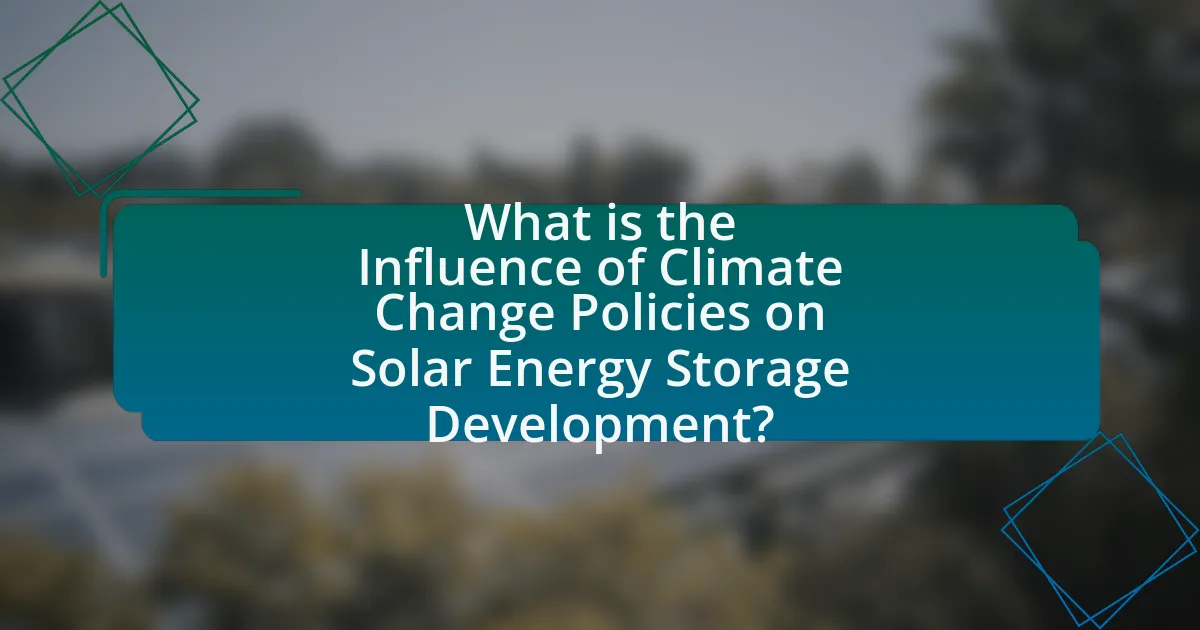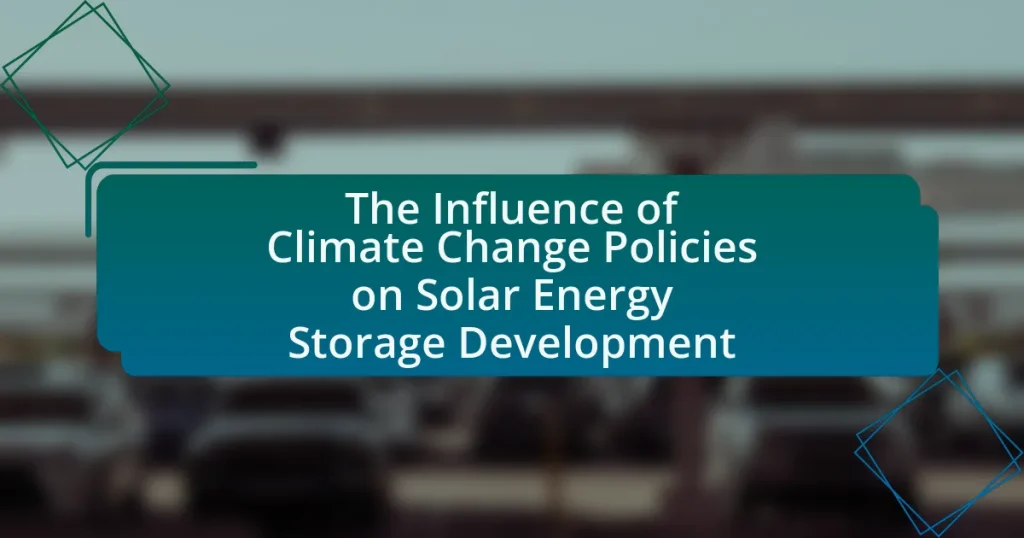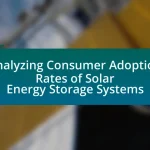The article examines the influence of climate change policies on the development of solar energy storage technologies. It highlights how government incentives, regulatory frameworks, and market stability foster investment and innovation in solar storage solutions, essential for managing the intermittent nature of solar power. Key policies such as tax credits, renewable energy standards, and net metering regulations are discussed for their role in enhancing the economic viability of solar energy storage. Additionally, the article addresses the challenges posed by regulatory constraints and funding limitations, while emphasizing the importance of solar energy storage in reducing greenhouse gas emissions and enhancing energy resilience. Emerging trends and best practices for effective solar energy storage development in alignment with climate policies are also explored.
What is the Influence of Climate Change Policies on Solar Energy Storage Development?


Climate change policies significantly influence solar energy storage development by promoting investment, innovation, and regulatory frameworks that enhance the viability of solar technologies. For instance, government incentives such as tax credits and subsidies for renewable energy projects encourage companies to invest in advanced storage solutions, which are essential for managing the intermittent nature of solar power. According to the International Renewable Energy Agency (IRENA), the global energy storage market is projected to grow substantially, driven by supportive policies aimed at reducing greenhouse gas emissions and transitioning to sustainable energy systems. Furthermore, regulations mandating renewable energy integration into the grid create a demand for efficient storage systems, thereby accelerating technological advancements and reducing costs in solar energy storage.
How do climate change policies impact the solar energy sector?
Climate change policies significantly enhance the solar energy sector by providing financial incentives, regulatory support, and market stability. These policies, such as tax credits and renewable energy mandates, encourage investment in solar technologies, leading to increased deployment and innovation. For instance, the Investment Tax Credit (ITC) in the United States has been pivotal, resulting in a 167% increase in solar capacity from 2015 to 2020, according to the Solar Energy Industries Association. Additionally, climate policies create a favorable environment for long-term contracts and power purchase agreements, which further stimulate growth in the solar market.
What specific policies are most influential in shaping solar energy storage?
The most influential policies shaping solar energy storage include renewable energy standards, tax incentives, and net metering regulations. Renewable energy standards mandate a certain percentage of energy to come from renewable sources, driving investment in solar storage technologies. Tax incentives, such as the Investment Tax Credit (ITC), provide financial benefits for solar installations, encouraging the integration of storage solutions. Net metering regulations allow consumers to receive credit for excess energy generated, promoting the use of solar storage systems to maximize energy efficiency. These policies collectively enhance the economic viability and adoption of solar energy storage solutions.
How do these policies affect investment in solar energy storage technologies?
Climate change policies significantly enhance investment in solar energy storage technologies by providing financial incentives and regulatory support. These policies often include tax credits, grants, and subsidies that lower the cost of solar energy systems and storage solutions, making them more attractive to investors. For instance, the Investment Tax Credit (ITC) in the United States allows investors to deduct a percentage of the cost of solar systems from their federal taxes, which has been shown to increase solar installations and related storage investments. Additionally, renewable energy mandates and clean energy standards create a stable market environment, encouraging companies to invest in innovative storage technologies to meet regulatory requirements. As a result, these policies not only stimulate immediate financial investment but also foster long-term growth and development in the solar energy storage sector.
Why is solar energy storage important in the context of climate change?
Solar energy storage is crucial in the context of climate change because it enables the efficient use of renewable energy, reducing reliance on fossil fuels. By storing excess solar energy generated during peak sunlight hours, systems can provide power during periods of low sunlight or high demand, thus stabilizing the energy supply. This capability supports grid resilience and facilitates the transition to a low-carbon energy system, which is essential for meeting global climate targets. According to the International Energy Agency, energy storage could account for up to 30% of the total energy system by 2040, significantly contributing to emissions reduction efforts.
What role does solar energy storage play in reducing greenhouse gas emissions?
Solar energy storage significantly reduces greenhouse gas emissions by enabling the efficient use of renewable energy. By storing excess solar energy generated during peak sunlight hours, energy storage systems allow for the use of this clean energy during periods of high demand or low sunlight, thereby decreasing reliance on fossil fuels. According to the International Energy Agency, integrating energy storage with solar power can lead to a reduction of up to 70% in carbon emissions from the electricity sector by 2040. This transition to stored solar energy not only enhances grid stability but also promotes a cleaner energy mix, ultimately contributing to global efforts in mitigating climate change.
How does solar energy storage contribute to energy resilience and security?
Solar energy storage enhances energy resilience and security by providing a reliable backup during power outages and reducing dependence on fossil fuels. By storing excess solar energy generated during peak sunlight hours, systems can supply power during periods of low generation or high demand, ensuring a continuous energy supply. For instance, during natural disasters or grid failures, solar storage systems can maintain critical services, as evidenced by the deployment of solar batteries in areas affected by hurricanes, which allowed essential facilities to remain operational. Additionally, integrating solar energy storage into the grid can stabilize energy supply, mitigate price volatility, and support the transition to a more sustainable energy system, thereby reinforcing overall energy security.
What challenges do climate change policies pose for solar energy storage development?
Climate change policies pose several challenges for solar energy storage development, primarily through regulatory constraints and funding limitations. These policies often prioritize immediate emissions reductions, which can lead to a lack of long-term investment in storage technologies that are essential for integrating solar energy into the grid. For instance, stringent regulations may limit the types of materials used in battery production, impacting the availability and cost of storage solutions. Additionally, funding for research and development may be diverted to other renewable technologies, hindering advancements in solar energy storage. According to a report by the International Renewable Energy Agency, investment in energy storage technologies has not kept pace with the growth of solar energy, indicating a significant gap that climate policies can exacerbate.
How do regulatory hurdles affect the deployment of solar energy storage systems?
Regulatory hurdles significantly impede the deployment of solar energy storage systems by creating barriers that increase costs and extend project timelines. For instance, complex permitting processes can delay installations, while inconsistent regulations across jurisdictions can lead to uncertainty for investors and developers. According to a report by the International Renewable Energy Agency, regulatory challenges are among the top barriers cited by stakeholders in the renewable energy sector, affecting the scalability and adoption of solar storage technologies. These hurdles can result in reduced market competitiveness and slower progress toward renewable energy goals, ultimately hindering the transition to a more sustainable energy system.
What economic barriers exist due to climate change policies for solar energy storage?
Economic barriers due to climate change policies for solar energy storage include high initial investment costs and limited access to financing. These policies often require advanced technologies that can be expensive to implement, which deters investment. Additionally, regulatory frameworks may impose stringent requirements that increase compliance costs for solar energy storage projects. For instance, the International Renewable Energy Agency reported that upfront costs for energy storage systems can be a significant hurdle, often exceeding $1,000 per kilowatt-hour. This financial burden can limit the scalability and adoption of solar energy storage solutions, ultimately hindering their development in the context of climate change policies.
How can stakeholders navigate the influence of climate change policies on solar energy storage?
Stakeholders can navigate the influence of climate change policies on solar energy storage by actively engaging in policy advocacy and aligning their strategies with regulatory frameworks. By understanding the specific provisions of climate change policies, such as incentives for renewable energy and emissions reduction targets, stakeholders can better position their solar energy storage projects to benefit from government support. For instance, the U.S. Inflation Reduction Act provides tax credits for solar energy investments, which stakeholders can leverage to enhance project viability. Additionally, stakeholders should collaborate with policymakers to ensure that their interests are represented in future legislation, thereby influencing the direction of climate policies that affect solar energy storage.
What are the emerging trends in solar energy storage influenced by climate change policies?
Emerging trends in solar energy storage influenced by climate change policies include the increased adoption of lithium-ion batteries, advancements in solid-state battery technology, and the integration of artificial intelligence for energy management. Lithium-ion batteries dominate the market due to their efficiency and declining costs, with prices dropping by approximately 89% since 2010, driven by government incentives and renewable energy mandates. Solid-state batteries are gaining traction as they offer higher energy densities and improved safety, aligning with policies aimed at reducing carbon emissions. Additionally, the use of artificial intelligence in energy storage systems enhances grid reliability and optimizes energy usage, reflecting the growing emphasis on smart grid technologies in climate policies. These trends collectively support the transition to a more sustainable energy landscape.
How are technological advancements responding to policy changes in solar energy storage?
Technological advancements in solar energy storage are increasingly aligning with policy changes aimed at promoting renewable energy. For instance, government incentives and regulations, such as tax credits and renewable portfolio standards, have spurred innovation in battery technologies, leading to the development of more efficient and cost-effective storage solutions. According to a report by the International Energy Agency, advancements in lithium-ion batteries have reduced costs by over 80% since 2010, driven by both market demand and supportive policies. These advancements enable greater integration of solar energy into the grid, enhancing reliability and encouraging further investment in renewable technologies.
What role do public-private partnerships play in advancing solar energy storage under climate policies?
Public-private partnerships (PPPs) significantly enhance the advancement of solar energy storage under climate policies by leveraging resources, expertise, and innovation from both sectors. These collaborations facilitate investment in research and development, enabling the creation of more efficient and cost-effective storage technologies. For instance, the U.S. Department of Energy has engaged in PPPs to fund projects that improve battery technologies, which are crucial for solar energy integration. Additionally, PPPs can streamline regulatory processes and provide access to funding mechanisms, such as grants and tax incentives, which are essential for scaling up solar energy storage solutions. This synergy not only accelerates technological advancements but also aligns with climate policies aimed at reducing greenhouse gas emissions and promoting renewable energy adoption.
What best practices can be adopted for effective solar energy storage development in light of climate change policies?
Effective solar energy storage development can be achieved by implementing best practices such as integrating advanced battery technologies, optimizing energy management systems, and ensuring regulatory compliance with climate change policies. Advanced battery technologies, like lithium-ion and solid-state batteries, enhance energy density and lifespan, making them suitable for large-scale solar applications. Optimizing energy management systems allows for better forecasting and utilization of solar energy, which is crucial for meeting demand during peak usage times. Furthermore, adhering to climate change policies, such as the Paris Agreement, encourages investments in sustainable technologies and incentivizes the adoption of renewable energy solutions, thereby fostering a supportive environment for solar energy storage development.


